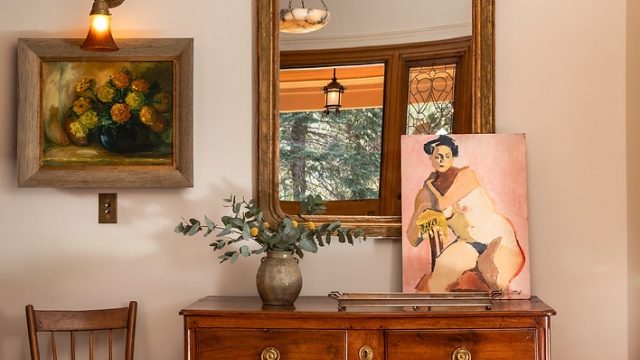
Transform Your Space: Unleashing the Art of Interior Design

Interior design is more than just arranging furniture or choosing paint colors; it is an art form that transforms a space into a reflection of our personalities, lifestyles, and aspirations. A well-designed interior can evoke emotions, promote well-being, and even enhance productivity. Whether you are looking to refresh a single room or completely renovate your home, understanding the principles of interior design can empower you to create environments that inspire and nurture.
As we delve into the world of interior design, we will explore the essential elements that contribute to a harmonious and functional space. From the balance of colors and textures to the importance of lighting and spatial arrangement, each aspect plays a crucial role in achieving a cohesive look. Unleashing the art of interior design allows you to express your creativity while ensuring that your space is not only beautiful but also practical. Join us on this journey to discover how to breathe new life into your surroundings.
Understanding Interior Design Principles
Interior design is an art form that blends creativity with functionality. At its core, it revolves around understanding the space, its purpose, and the emotions it elicits. The principles of interior design focus on how various elements come together to create harmony within a space. This includes exploring aspects such as balance, contrast, scale, and proportion, which are essential in crafting an aesthetically pleasing environment.
Balance refers to the distribution of visual weight in a room. It can be symmetrical, where elements are arranged evenly, or asymmetrical, where a more dynamic and informal arrangement is achieved. Utilizing balance effectively helps to create a sense of stability and comfort. Meanwhile, contrast brings different elements together, highlighting unique features and creating visual intrigue. By contrasting colors, textures, or shapes, designers can create focal points that draw attention and enhance the overall design.
Scale and proportion are critical in ensuring that the furniture and decor fit harmoniously within the space. Scale refers to the size of an object in relation to the surrounding space, while proportion relates to the size relationships between objects themselves. Understanding these concepts allows designers to select pieces that complement each other and the room as a whole, ensuring a cohesive and inviting atmosphere that reflects the personal style of its inhabitants.
Choosing the Right Color Palette
Selecting the right color palette is a crucial step in the interior design process. Colors can evoke emotions, set the mood, and influence the perception of space. It is important to consider the purpose of the room when choosing colors. For instance, softer, muted tones work well in bedrooms for a calming atmosphere, while vibrant and energizing colors can invigorate a living room or home office. Take the time to gather inspiration from various sources, such as nature, artwork, or even fabric swatches.
When creating your color scheme, consider the 60-30-10 rule for a balanced look. This guideline suggests using 60 percent of a dominant color, 30 percent of a secondary color, and 10 percent of an accent color. The dominant color usually covers the walls and large furnishings, while the secondary color can be applied through textiles and accessories. Accent colors provide visual interest and personality, so choose shades that complement your primary choices and add depth to your design.
Lastly, remember that lighting can significantly affect how colors appear in a space. Natural light can alter the perception of colors throughout the day, while artificial lighting can add warmth or coolness depending on the bulb used. Test paint samples in different lighting conditions to see how they change throughout the day. Ensuring that your chosen colors harmonize under various lighting scenarios will help create a cohesive and inviting atmosphere in your home.
Furniture Selection and Layout
Choosing the right furniture is essential in transforming a space into a functional and aesthetically pleasing environment. Consider the purpose of the room and the activities that will take place there when selecting furniture. Opt for pieces that not only fit within your design theme but also cater to comfort and usability. Look for styles that resonate with your personal taste, whether it’s modern, traditional, or eclectic, to create a harmonious atmosphere.
Once you have selected suitable furniture pieces, the next step is to thoughtfully arrange them within the space. Start by measuring the dimensions of the room and the furniture to ensure everything fits well. Aim for a layout that encourages easy movement and conversation. Position larger items, like sofas or beds, first, and then incorporate smaller accent pieces to create balance and interest.
Don’t forget about the importance of scale and proportion in your layout. Furniture that is too large can overwhelm a small room, while tiny pieces may get lost in a spacious area. Use rugs, lighting, and accessories to define spaces and add layers to your design. A well-thought-out furniture selection and layout not only enhance the functionality of the space but also reflect your unique style, making it truly yours.
Sandy Baisley interior design portfolio
Incorporating Personal Style
When it comes to interior design, integrating personal style is essential for creating a space that feels uniquely yours. This often begins with understanding your preferences in color, texture, and form. Consider elements that resonate with you, whether it be modern minimalism, rustic charm, or vibrant bohemian flair. Let these influences guide your choices, allowing your home to reflect your personality and lifestyle.
Another way to express personal style is through the selection of accessories and artwork. These items can tell a story about your experiences and interests. Incorporate pieces that you love, whether they are family heirlooms, travel souvenirs, or avant-garde artworks. By curating a collection of meaningful items, you transform your space into a captivating narrative that showcases who you are.
Finally, don’t shy away from experimentation. Interior design is a fluid process that allows for adjustments as your style evolves. Mixing different elements—like contemporary furnishings with vintage finds—can create a visually engaging contrast. Embrace the journey of discovering what works for you. Ultimately, your space should be a sanctuary that not only meets your functional needs but also celebrates your individuality.



